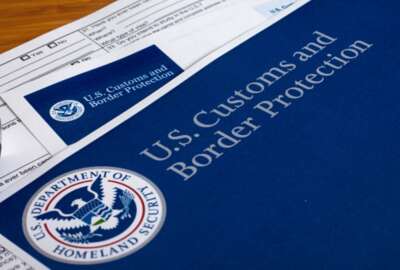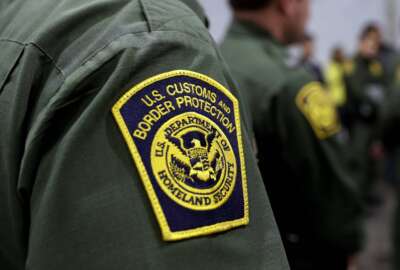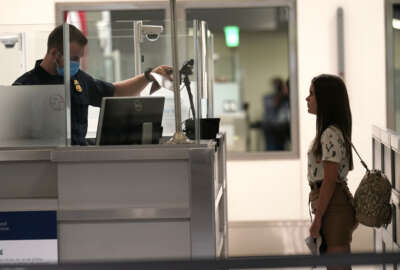Sponsored by Zebra Technologies
CBP explores cloud, RFID, QR codes to modernize seized goods inventory
CBP seizes massive quantities of illicit goods each year that have to be logged, weighed or otherwise measured, and then tracked across multiple systems.
In 2023, the Customs and Border Protection’s Office of Field Operations seized 549,000 pounds of illicit drugs, 3,110 guns and 501,368 rounds of ammunition. And that’s not even getting into the live animals, meats, agricultural products, jewelry, counterfeit goods and even vehicles, all of which CBP Director of Fines, Penalties and Forfeitures Lisa Santana Fox refers to as “violative” materials.
The Homeland Security Department Agency must log, weigh or otherwise measure, and enter these items into a variety of systems to track them, Fox explained.
That’s where CBP sees an opportunity for modernization: By integrating those systems, automating the entry of some of the data and introducing newer digital tools for inventory tracking, it can make the agency’s systems more accurate and ease some of the burden on frontline employees.
“At least in the cargo arena where a manifest was transmitted to us, it goes through some systems. And then if they have to make entry on the goods, it goes through another system. And then if we interdict it and seize it, it’s another system,” Fox said on The Modernized Warehouse. “So tying those systems together, so that the frontline officers — the seized property specialists … they’re not keying in information. It comes in and we just push it from one system to the next. That cuts down on the opportunity for error.”
CPB looks to cloud to track seized goods
Fox said this would most likely be accomplished through a cloud-based platform, enabling smoother integration of the systems and data.
CPB also wants to do the same with its scales. When CBP interdicts narcotics, it must weigh what’s been seized immediately, then again when the narcotics go into the vault — and when they come out of the vault too — to ensure none disappears during the process. And each of those weights has to be manually entered now. But digital scales could record weight automatically, reducing the potential for error, Fox said.
Likewise, all of the seized inventory has to be managed while it’s in CBP custody. Violative materials like agricultural products are destroyed immediately, to keep them from contaminating the environment.
Other goods are held through to other final dispositions. Sometimes they’re returned to the owners, other times they’re destroyed, and sometimes they’re held by CBP or transferred to another relevant agency to hold as evidence for legal proceedings.
Taking advantage of RFID, QR codes to track seized goods
Currently, CBP tracks all of that by seizure number across its various systems, a process that Fox described as “labor intensive.” That’s why it’s currently piloting the use of RFID tags for its warehouses to speed up that process and reduce the workload. The agency is also experimenting with QR codes as an alternative to manually entering data.
But even those methods have potential complications because of CBP’s unique mission, Fox said. For example, most violative materials are kept in vaults with walls “at least two feet thick,” she said. That makes it difficult to get Wi-Fi into locations even for the current tracking system that uses tablets to track the case numbers.
“We’ve been seizing goods for hundreds of years, just getting into the 21st century. So right now we’re kind of limited to the vault operation and being able to track and streamline our inventories, which will ultimately save us time,” Fox said on the Federal Drive with Tom Temin. “But who knows what they’re going to invent next year? So we’re constantly looking for opportunities to try new things, so that we have the best equipment, the best technology for our team out in the field.”
All of this is in service of CBP’s goal of getting better data analytics intelligence around its inventory of seized goods. Not only will that enable better tracking, but it could also potentially reveal insights that lead from one smaller, seemingly isolated incident to a much larger operation.
“The data that’s captured in the systems of record goes into platforms, data warehouses where they can be analyzed, manipulated. We feed that intelligence back into our targeting so that we’re better targeting on the front end to interdict better across the enterprise,” Fox said. “And then reporting — we’re reporting to Congress. We report on CBP.gov. We’re constantly reporting our statistics and the efforts that we have undertaken to the public so they know what we’re out there doing.”
Discover technologies and tactics that other federal agencies are taking to modernize their logistics and warehouse operations in our series The Modernized Warehouse.
Copyright © 2025 Federal News Network. All rights reserved. This website is not intended for users located within the European Economic Area.
Daisy Thornton is Federal News Network’s digital managing editor. In addition to her editing responsibilities, she covers federal management, workforce and technology issues. She is also the commentary editor; email her your letters to the editor and pitches for contributed bylines.
Follow @dthorntonWFED






